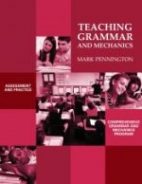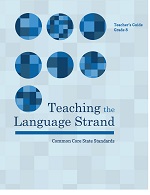How to Teach Writing Mechanics
How to Teach Writing Mechanics asks and provides possible answers to the What is (and isn’t) Writing Mechanics, Why Teach Writing Mechanics? When Should We Teach Writing Mechanics? What Writing Mechanics Should We Teach? How Should We Teach Writing Mechanics? How Much Class Time for Writing Mechanics? questions related to teaching the nuts and bolts of punctuation, capitalization, formatting, citations, quotations, etc. Disclaimer: The author has published several writing mechanics resources.
What is (and isn’t) Writing Mechanics?
Since this is a “catch-all” subject, let’s discuss what I do mean and don’t mean by writing mechanics. I do mean punctuation (commas, periods, colons, semicolons, dashes, ellipses, parentheses, and brackets), capitalization (including proper nouns, common nouns, abbreviations, and acronyms), formatting (paragraphing, indentations, when to skip and not skip lines, proper headings and spacing, what goes where and what does not), citations (MLA rules, the purpose thereof, and creative problem solving including references, in-text formatting, and list of works), quotations (direct, indirect, titles of works, and dialogue rules). I did mention rules, as no doubt you noticed. However, mechanics is also about style and coherency. “Let’s eat Grandma” comes to mind. Or how about…
I’M STUFFED DO WE HAVE TO EAT GRANDMA AFTER ALL WE JUST FINISHED EATING GRANDPA CAN’T WE WAIT UNTIL MOM’S DONE COOKING
Your students will love more of these examples.
Some teachers would, but I don’t mean grammar. Grammar refers to the sentence components and their functions, such as the parts of speech, subjects, predicates, objects, and modifiers. Grammar also means the arrangement of words within the sentence (the syntax), the formation of phrases and clauses, and word choice. Additionally, grammar includes study and practice in the accepted rules of proper usage, such as subject and verb agreement, pronoun and antecedent relationships, and whether to split infinitives or end sentences with prepositions. Finally, grammar is used to identify and correct non-standard usage. Check out a related article on How to Teach English Grammar.
I also don’t mean spelling. The authors of the Common Core State Standards lump the entire kitchen sink into the “language conventions” category. However, as an MA reading specialist, I will assure you that spelling (encoding) has much more to the how-to’s of reading (decoding) and vocabulary than with proper comma usage.
Why Teach Writing Mechanics?
The authors of the Common Core include writing mechanics in a separate Language Strand as Standard L. 2., and the accompanying Smarter Balanced and PAARC tests do test mechanics. Teaching mechanics will not only help your students avoid eating Grandma, but will also provide a forum for rich language discussion. The differences in British and American punctuation are fascinating. The changing nature of mechanics rules and the controversies between editors of new and old media are instructive. Want to raise a real ruckus? Try debating the serial comma rule! By the way, I don’t consider myself a serial comma killer.
When Should We Teach Writing Mechanics?
The Common Core State Standards have shifted so much of the language conventions to the primary or intermediate elementary grade levels. Such is the case with mechanics. Of course, review is essential and it is nice to have the recursive nature of language instruction validated by the Common Core authors. So, writing mechanics is certainly a K-12 focus.
What Writing Mechanics Should We Teach?
Because of the downward shift in terms of instructional responsibility, it does make sense for upper elementary, middle school, and high school teachers to begin teaching more complex writing mechanics skills. Building on prior knowledge will allow teachers of older students to “get to” issues of, say punctuation and capitalization that heretofore (always wanted to use that word) have never been addressed. It does makes sense to share the instructional load and to prioritize instruction. Layered, sequenced instruction makes sense. An establish scope and sequence makes more sense than a fix-the-random-error “curriculum,” such as DOL or DLR. Most of us old veterans of Daily Oral Language or Daily Language Review would agree that these “error fix-a-thons” (Jeff Anderson) never transferred to student speaking or writing. District committees and instructional teams at the site level can and should align and sequence instruction.
How Should We Teach Writing Mechanics?
Both direct and individualized instruction are needed to teach students writing mechanics. We do need to up the rigor of direct instruction as explained above, but we also need to build on individual student strengths and weaknesses. Because primary and intermediate elementary teachers are transitioning to more writing mechanics instruction, older students will have even a greater diversity of skills sets. Teachers can choose to teach as if none of their students knows anything and repeat the instruction that some have received, or use diagnostic assessments to determine mastery of writing mechanics for each student and provide remediation to those who need it.
Effective diagnostic assessments will help teachers identify what grammatical concepts and skills students have and have not mastered from previous grade levels. Here’s an effective 32 question writing mechanics assessment (with answers) and recording matrix. Teachers can create mini-lessons and/or assign remedial worksheets to correspond to items on the diagnostic assessment to “catch up” individual students to grade level direct instruction. Of course, my grades 4-8 programs provide these resources.
How Much Class Time for Writing Mechanics (and all Language Conventions) Instruction?
Most English-language specialists suggest that short, interactive language conventions lessons, including writing mechanics, (say 20−30 minutes twice per week with a focus on just a few skills, including a brief review to connect to prior learning) makes sense. Clear examples and quick practice in which students apply the skill or rule and identify what is correct and what is not helpful. Short dictation sentences in which students apply the writing mechanics focus will serve as formative assessments to inform the teacher as to mastery or if re-teaching is necessary. Less effective is the “teach writing mechanics only in the editing stage of process papers” approach via mini-lessons. Direct instruction makes a difference. Individualized instruction with targeted worksheets (corresponding to the diagnostic assessments) can add another 15-30 minutes of classroom instruction per week or be assigned as homework.
*****

Pennington Publishing Grammar Programs
Teaching Grammar, Usage, and Mechanics (Grades 4, 5, 6, 7, 8, and High School) are full-year, traditional, grade-level grammar, usage, and mechanics programs with plenty of remedial practice to help students catch up while they keep up with grade-level standards. Twice-per-week, 30-minute, no prep lessons in print or interactive Google slides with a fun secret agent theme. Simple sentence diagrams, mentor texts, video lessons, sentence dictations. Plenty of practice in the writing context. Includes biweekly tests and a final exam.
Grammar, Usage, and Mechanics Interactive Notebook (Grades 4‒8) is a full-year, no prep interactive notebook without all the mess. Twice-per-week, 30-minute, no prep grammar, usage, and mechanics lessons, formatted in Cornell Notes with cartoon response, writing application, 3D graphic organizers (easy cut and paste foldables), and great resource links. No need to create a teacher INB for student make-up work—it’s done for you! Plus, get remedial worksheets, biweekly tests, and a final exam.
Syntax in Reading and Writing is a function-based, sentence level syntax program, designed to build reading comprehension and increase writing sophistication. The 18 parts of speech, phrases, and clauses lessons are each leveled from basic (elementary) to advanced (middle and high school) and feature 5 lesson components (10–15 minutes each): 1. Learn It! 2. Identify It! 3. Explain It! (analysis of challenging sentences) 4. Revise It! (kernel sentences, sentence expansion, syntactic manipulation) 5. Create It! (Short writing application with the syntactic focus in different genre).
Get the Diagnostic Grammar, Usage, and Mechanics Assessments, Matrix, and Final Exam FREE Resource:
![]()
Get the Grammar and Mechanics Grades 4-8 Instructional Scope and Sequence FREE Resource:
![]()


